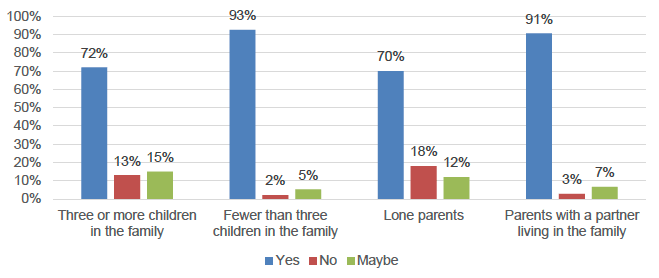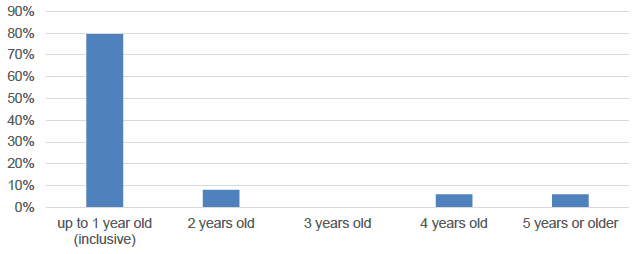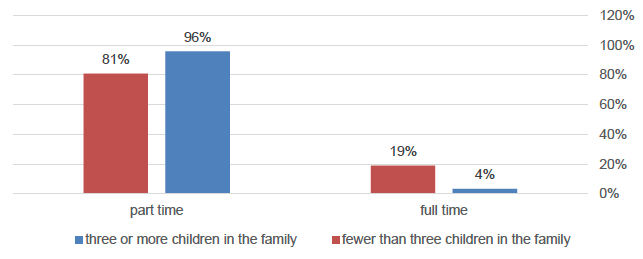Understanding Society - Gender and Work in Scotland: research findings
Analyses data from Understanding Society on mothers returning to work and gender roles and attitudes
This document is part of a collection
Mothers Returning to Employment
This section focuses on the employment trajectories of women who have recently had a baby. Mothers who had taken maternity leave in the last year were asked about their intentions to return to employment, and the job statuses of mothers and fathers after a baby was born were tracked over time.
Further analysis of the responses was carried out for single mothers compared to those with a co-resident partner, families with a disabled adult or child compared to those without, families with three or more children compared to those with fewer than three children, families with a child under one year old compared to those without, and age of parent in three categories: under 25, 25-34 and 35 or older. Single fathers were not identified as none had a newborn baby living in their household. There were too few ethnic minority parents for further analysis by ethnicity (22 mothers and 13 fathers).
Intentions to Return to Employment
Mothers who had taken a period of maternity leave in the last year were asked about their intentions to return to employment from Wave 3 (2011-2012) onwards. They were asked if they intend to return to employment, the age of the child when they intend to return to employment, if they intend to return full-time or part-time , and their reason for not intending to return to employment. In Scotland a total of 176 responded to whether they intend to return to employment, and 182 indicated the age of their child when they intended to return. Babies who had been born since the previous wave were identified from Wave 2 (years) onwards.
Whether new mothers intend to return to employment
The majority of new mothers (89%) said they did intend to return to employment, compared to 4% who said they did not. One-hundred percent of mothers with no children under 1 in the family said they intended to return to employment.
Mothers in each of the child poverty priority groups[3] were less likely than mothers who were not in any of these priority groups to say they intended to return to employment, more likely to be undecided about returning to employment, and more likely to say they did not intend to return to employment. The only exception was mothers with a disabled person in the family: no mothers in this group said they did not intend to return to employment, compared to 5% of new mothers in families with no disabled person.
The most significant difference in responses were seen in families with three or more children compared to families with fewer than three children, and in single mothers compared to mothers with a co-resident partner. These comparisons are shown in Figure 1 (below). Among mothers in families with three or more children, 72% intended to return to employment and 13% did not, compared to 93% of mothers in families with fewer than three children who intended to return to employment and 2% who did not. Similarly, 70% of single mothers intended to return to employment and 18% did not, compared to 91% of mothers with a co-resident partner who intended to return to employment and 3% who did not.
Figure 1: Responses from new mothers about their intention to return to employment

Source: Understanding Society Wave 3 (2011-2012) onwards.
Reasons for not intending to return to employment
The most common reason given for not intending to return to employment was, "I prefer to look after my child", with 80% of mothers who did not intend to return to employment giving this response.
Other common reasons related to difficulties in finding a job with suitable pay and hours (note that mothers could give multiple reasons):
- "I cannot earn enough to pay for childcare" (27%).
- "I cannot find suitable childcare" (20%).
- "There are no jobs with the right hours for me" (20%).
Less common reasons included "I prefer not to work" (8%), and "My family would lose benefits if I was earning" (5%). Nine percent said that there was some other reason for not returning to employment.
There were also a number of reasons for not returning to employment which received no responses. These related to suitability of jobs, education status, caring responsibilities for elderly or ill people, poor health, and disapproval from a partner.
Age of the child when the mothers intends to return to employment
Figure 2 (below) shows the age of the child when the mother intends to go back to employment. The majority of mothers (80%) intend to go back to employment when the child is up to one year old. Sample sizes for the inter-group comparisons were small and so these have not been included.
Figure 2: Age of child when mother intends to start work in the future

Source: Understanding Society Wave 3 (2011-2012) onwards.
Whether new mothers intend to return to employment part-time or full-time
In general, new mothers who intended to return to employment were more likely to plan to go into part time employment rather than full time employment. The most significant difference in responses was for mothers in families with three or more children compared to mothers in families with fewer than three children, shown in Figure 3 (overleaf). Nineteen percent of mothers in families with fewer than three children intend to return to full time employment, compared to 4% of mothers with three or more children in the family. Furthermore, the age of the child when the mother intends to return to employment was generally lower for mothers in families with fewer than three children, than it was for mothers in families with three or more children.
Figure 3: Responses to working full time or part time in the future among mothers who intend to return to employment

Source: Understanding Society Wave 3 (2011-2012) onwards.
Employment Trajectories
Job statuses of mothers and fathers were compared between the wave at which the newborn was first recorded in the family and the following wave. The comparisons have been made for all mothers and fathers, broken down by demographic variables and the employment status in the wave before the baby was first recorded. All demographic variables used for the breakdowns were recorded when the newborn baby was first recorded in the family.
Differences in rate of employment
For all mothers and fathers who responded to this part of the survey, there were increases in the percentage who were in employment (either full-time, part-time or self-employed) between the wave when the newborn was first recorded and the following wave. The increases were generally larger for mothers than for fathers, although the percentage of parents in employment generally started higher for fathers than for mothers.
These increases were observed in each of the demographic and employment groups. However, mothers and fathers in the child poverty priority groups were less likely than mothers and fathers who were not in these groups to be employed when the newborn was first recorded. For example, when a newborn was first recorded, 21% of single mothers were in employment, compared to 45% of mothers with a co-resident partner. Although employment increased in all groups in the wave following the birth of the newborn, these initial differences in employment status were still apparent.
Differences in type of employment
There were differences in the type of employment mothers and fathers took up (Figures 9-14, Annex A). At the wave the newborn was first recorded, the rate of full-time employment was higher for all fathers compared to all mothers, and the rate of part-time employment was higher for all mothers compared to all fathers. This pattern continued in the next wave.
Furthermore, for all mothers, the largest increase in employment status between the wave when a child was born and the next wave was seen in part-time employment, with full-time employment and self-employment remaining at similar levels. For all fathers, by contrast, full-time employment increased. The largest change was seen among fathers under age 25, for whom full-time employment increased from 52% to 87%. Meanwhile, part-time employment decreased for all fathers. The largest change was seen for fathers with no children under age 1, for whom part-time employment dropped from 33% to 3%. For all fathers, self-employment remained at a similar level.
Differences in rates of unemployment
Rates of parents who were unemployed or looking for employment varied across demographic variables (Figures 15-16, Annex A). Single mothers, mothers under age 25, and fathers under age 25 were more likely to be unemployed or looking for employment when the newborn was first recorded than all mothers and all fathers, and mothers and fathers in every other group. For single mothers and mothers under age 25 there was also a higher percentage who were unemployed or looking for employment compared to all mothers in the next wave. For all fathers, including fathers under age 25, the percentage who were unemployed or looking for employment fell to 0% at the wave after the newborn was first recorded.
Differences in labour market participation
There were large differences in the percentage of mothers and fathers carrying out family care or who were not in employment for other reasons (Figures 17-18, Annex A). For mothers, the only groups for whom the rate of family care and inactivity dropped was mothers aged 35 or older, and mothers with no children under age one. Mothers in families with three or more children and mothers who were not in employment before the newborn was born had particularly high rates of family care or inactivity at the wave the newborn was first recorded, which remained high in the next wave. By contrast, the percentage of fathers carrying out family care or who were inactive remained at, or fell to 0%, across all groups.
Furthermore, mothers in child poverty priority groups were more likely to be carrying out family care or to be inactive than mothers who were not in these groups. For example, 39% of single mothers were carrying out family care or were inactive when the newborn was first recorded. This compares to 20% of mothers with a co-resident partner. Despite a general increase in family care and inactivity, these differences were still apparent.
Contact
Email: Spencer.Thompson@gov.scot
There is a problem
Thanks for your feedback